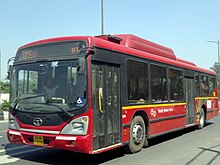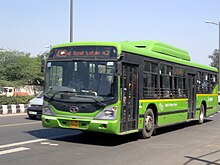The Mudrika Seva is one of the most popular bus routes in Delhi, India. It was started by the Delhi Transport Corporation (DTC) in May 1974, and is now operated by both the Corporation and DIMTS' cluster buses. The service runs on Delhi's inner ring road, with major stops at AIIMS, Lajpat Nagar, Sarai Kale Khan, ITO, Delhi Gate, Kashmere Gate, DU North Campus, Model Town, Azadpur market, Shalimar Bagh, Punjabi Bagh, Britannia Factory, Rajouri Garden, Naraina, and DU South Campus.
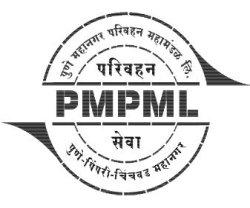
Pune Mahanagar Parivahan Mahamandal Ltd (PMPML) is the public transport bus service provider for the city of Pune, India.

Delhi has significant reliance on its transport infrastructure. The city has developed a highly efficient public transport system with the introduction of the Delhi Metro, which is undergoing a rapid modernization and expansion since 2006. There are 16.6 million registered vehicles in the city as of 30 June 2014, which is the highest in the world among all cities, most of which do not follow any pollution emission norm, while the Delhi metropolitan region has 11.2 million vehicles. Delhi and NCR lose nearly 42 crore man-hours every month while commuting between home and office through public transport, due to the traffic congestion. Therefore, serious efforts, including a number of transport infrastructure projects, are under way to encourage usage of public transport in the city.
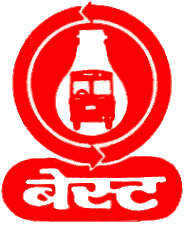
The Brihanmumbai Electricity Supply and Transport Undertaking (BEST) is a civic transport and electricity provider public body based in Mumbai, Maharashtra, India. It was originally set up in 1873 as a tramway company called "Bombay Tramway Company Limited". The company set up a captive thermal power station at the Wadi bunder in November 1905 to generate electricity for its trams and positioned it to also supply electricity to the city and re-branded itself to "Bombay Electric Supply & Tramways (BEST)" Company. In 1926, BEST also became an operator of motor buses. In 1947, the BEST became an undertaking of the Municipal Corporation and rebranded itself to "Bombay Electric Supply & Transport (BEST)". In 1995 the organisation was renamed to "Brihanmumbai Electric Supply & Transport (BEST)" alongside Mumbai. It now operates as an autonomous body under the Municipal Corporation.

Calcutta Tramways Company (CTC) was a state-run company that operated trams and buses in and around Kolkata in West Bengal, India. The Kolkata tram is the only operating tramway in India and is the oldest electric tram in India, operating since 1902.
In India, an Inter State Bus Terminal or Inter-State Bus Terminus (ISBT) is a bus terminus that provides bus service to destinations located in other states. An ISBT may also provide bus services to destinations in the same state. Mostly ISBT Term is used in the Northern Part of India, In the western part of India, ST Stand or State Transport Term is used.

Rajasthan State Road Transport Corporation (RSRTC) is a public transport company which provides bus services in the Indian state Rajasthan. It is headquartered in Jaipur, Rajasthan. The corporation was established by Government of Rajasthan on 1 October 1964 under the Road Transport Act 1950. RSRTC operates ordinary, express and deluxe services. It has 4100 buses in its fleet, 52 depots across Rajasthan and 3 depots outside the state i.e. Indore, Ahmedabad and Delhi. There are around 2230 routes covered which amount to 5437.74 lakh km per year. It carries around 9 lakh passengers per day to their destinations within and outside the state. RSRTC operates services in Rajasthan and adjoining states of Haryana, Punjab, Delhi, Uttar Pradesh, Himachal Pradesh, Madhya Pradesh, Gujarat, Maharashtra, Uttarakhand, Jammu Kashmir and Chandigarh. Ticket reservation is available at all bus stations free of charge. Online ticket facility is available for Air conditioned, Deluxe, Semi-deluxe and express buses through Kiosks in Rajasthan as well as through RSRTC mobile application.
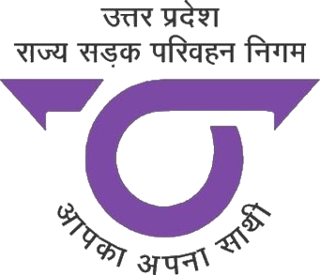
The Uttar Pradesh State Road Transport Corporation (UPSRTC) is a public sector passenger road transport corporation which services Uttar Pradesh, India, and adjoining states of North India. It operates as a state and interstate bus service and has the largest fleet of buses in North India. The corporate office of the corporation is located at MG Marg in Lucknow.
The Delhi BRTS was a bus rapid transit system in Delhi. The first route opened in 2008 ahead of the 2010 Commonwealth Games, which were held in the city. The project was well used but was criticised for the difficulty of access to the bus platforms, which were in the middle of the road, for lack of enforcement and for the effect it had on other motor traffic. A legal challenge was defeated in 2012. The Aam Aadmi Party Government had announced the scrapping of bus rapid transit system and it was dismantled in 2016, because of traffic congestion and accidents.
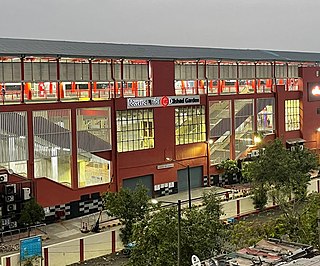
The Dilshad Garden metro station is a station of the Red Line of the Delhi Metro.

Anand Vihar is an interchange metro station located on the Blue Line and the Pink Line of Delhi Metro. The station is located in the Anand Vihar locality near the interstate border between Delhi and Uttar Pradesh and is a major connectivity hub of East Delhi. It is connected to the Anand Vihar ISBT and Anand Vihar Railway Terminal.

The Hauz Khas metro station is an interchange station between the Yellow Line and the Magenta Line of the Delhi Metro. It serves Hauz Khas Enclave, Sarvapriya Vihar, Vijay Mandal Enclave, RBI colony, Mayfair Gardens and the IIT Delhi. The entrance to the station is located on Outer Ring Road, to the east of Aurobindo Marg and to the west of Khelgaon Marg.

Haryana Roadways State Transport (HR) is the public transport unit of the Government of Haryana in India. Haryana Roadways is a major part of Haryana Transport Department. It is the principal service provider for passenger transport in the state. The Consistent quality and punctuality of the service provider, apart from the polite behaviour of the staff have earned a name in all neighbouring state. They have become the first choice of the passengers.
Badarpur is a historical town situated in the South East Delhi district of National Capital Territory of Delhi, India.The area of Badarpur encompasses both an NTPC thermal power station and an ancient village known as Badarpur village.The Village is dominated by Gurjars Mostly (Rexwal,Payla,Nagar,Dayma).

The Millennium Park Bus Depot was a major bus station located in Delhi, India. It was the largest bus depot in the world. Constructed primarily by the city's Public Works Department, the depot was inaugurated on 17 September 2010. The depot occupied an area of 243,000 m2, and had the capacity to park up to 1,000 buses at a time under shed, constituting 14% of the total parking capacity of all DTC depots combined. Though initially used exclusively for the 2010 Commonwealth Games, the depot was used as a regular bus station operated by the Delhi Transport Corporation post the Games. While the benefits of the depot were well-recognized, the depot was also the center of much controversy and criticism especially regarding its "temporary" nature and the violation of environmental norms.
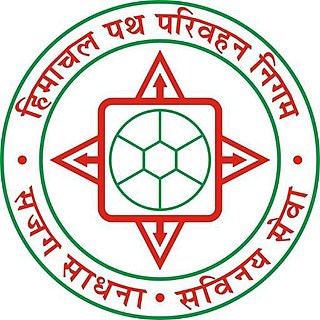
Himachal Road Transport Corporation, also referred to as HRTC, is the state-owned road transport corporation of the state of Himachal Pradesh, India. HRTC provides bus services to towns and cities within Himachal Pradesh and the adjoining and nearby states of Uttarakhand, Punjab, Haryana, Delhi, Uttar Pradesh, Jammu and Kashmir and Rajasthan. HRTC is one of the first RTC's in India to offer a facility for online booking of tickets for all types of buses.

The Uttarakhand Transport Corporation (UTC), also known as Uttarakhand Roadways, is the government-run bus service for the state of Uttarakhand, India. UTC operates buses throughout Uttarakhand and connects it to neighboring states such as Himachal Pradesh, Uttar Pradesh, Punjab, Haryana, Delhi, Chandigarh, Rajasthan, Jammu, and Madhya Pradesh. With a vast network exceeding 350,000 kilometers, UTC caters to over 100,000 daily passengers.
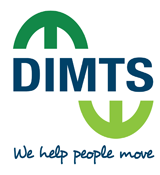
Delhi Integrated Multi-Modal Transit System (DIMTS) Limited is a transport consultancy and infrastructure development company. It is a joint venture company with equal equity of the Government of National Capital Territory of Delhi (GNCTD) and the IDFC Foundation.

The Maharana Pratap Interstate Bus Terminus (Maharana Pratap ISBT), popularly known as Kashmere Gate Interstate Bus Terminus (Kashmere Gate ISBT), located in Delhi, is the oldest and one of the biggest Inter-State Bus Terminals in India. It operates bus services between Delhi and the neighbouring states and union territories of Haryana, Jammu and Kashmir, Ladakh, Punjab, Himachal Pradesh, Uttar Pradesh, Rajasthan and Uttarakhand. Spanning about 5.3 acres, it handles over 1,800 buses a day.

The Swami Vivekanand Interstate Bus Terminus (Swami Vivekanand ISBT), popularly known as Anand Vihar Interstate Bus Terminus (Anand Vihar ISBT), located in Delhi is one of the three Inter State Bus Terminals in Delhi. It operates bus services between Delhi and the neighbouring states of Uttar Pradesh and Uttarakhand.

